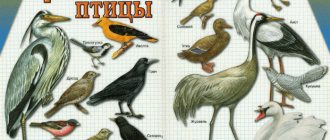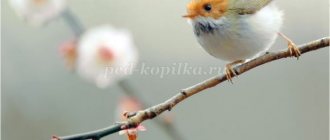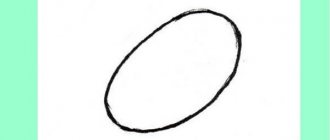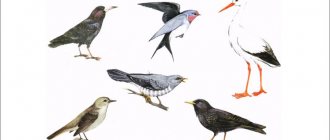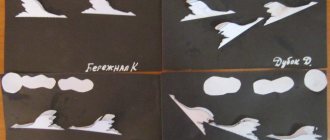Lexical topic “Migratory birds” relationship with the teacher
Finger gymnastics
| Migratory birds The birds in the sky are melting, melting Birds fly away to the south. Everyone melted away Stork, herons, cranes | We wave our hands Palm with visor facing forehead Bend the little finger, ring and middle fingers in turn |
Breathing exercises
"Feather"
(we blow on the feathers while exhaling and say: “Pf-pf...)
"Stork"
Let's imagine that we have turned into a stork, walking with an important air through the swamp. The head is raised proudly, the back is straight. The wing arms are extended to the sides. As you inhale, raise your “wings” and one leg, bending it at the knee. Then we straighten the knee and stretch the toe forward. As you exhale, slowly lower your arms and legs, taking a step and saying “sh-sh-sh...”. Same with the other leg. It is recommended to repeat alternating inhalation and exhalation 6-7 times.
"Geese are flying"
Slowly walking around the room. As you inhale, raise your arms to the sides; as you exhale, lower it, saying a long: “G-u-u-u.” Duration 60 seconds.
Development of articulatory motor skills.
"Beaks of different birds."
Slowly suck your cheeks into the gap between your teeth. Lips are tightly closed and extended forward
"Hungry Chicks"
Open your mouth as wide as possible (the tongue lies at the bottom of the mouth, the tip rests against the lower teeth) and pronounce the syllables: “Am-am-am-am-am.”
Exercises for cheeks and lips.
“The mother bird drives the marten away from the chicks.”
Suck the upper lip under the lower one, and then sharply throw it out with your mouth open (smacking).
Tongue exercises
-
“The chicks are waiting for food.”
Make a “cup” out of your tongue and hold it for a count of six.
“Very tasty food!”
Suck your “wide” tongue to the palate, then pronounce the sound a-a-a.
"Stork".
Pull the “sharp” tongue out of your mouth as far as possible and hold it for a count of “six to eight.”
Development of facial muscles.
In autumn you said goodbye to the birds, ( Sad
).
Depict hungry birds on a frosty day. Convey your emotional state, you sympathize with the birds, feel sorry for them. Sad, pitiful face
).
The starling fell into the paws of the cat. ( Fear
) The birds returned from warm countries.
( Joy)
Lexical topic: “Birds of passage”
A story about birds
of birds in nature . Wherever you walk - in a city park, along the seashore, in a village, in a forest - you will meet birds . Almost all of them can fly. Birds are animals with feathers and wings. Feathers help retain heat and give birds their unique colors. Birds often preen themselves , that is, they clean their feathers by rubbing their fat into them. They also pull out old feathers where new ones grow. Birds live in nests . They usually build nests from leaves, grass, and twigs, but some birds live in piles of stones. The female lays eggs and then incubates them, warming them with her warmth until the chicks hatch. In autumn, birds gather in flocks and fly south to spend the winter .
Tell the children about migratory birds.
Migratory birds are those birds that in late autumn and winter do not find food for themselves and fly away to warm regions where there is plenty of food.
Insectivores, marsh and waterfowl are flying away from us. And why?
Starlings, rooks, cuckoos and other insectivorous birds feed on insects. In autumn, insects hide in the bark of trees, burrow into the ground, find secluded places and spend the winter there. Birds cannot find insects, they become hungry and cold; they fly away.
Wading and waterfowl feed on small fish, frogs, and aquatic insects. In autumn it is cold - frogs and aquatic insects hibernate. In winter, the water turns to ice - the birds cannot reach the fish.
Talk about the benefits that migratory birds bring.
Nouns:
swallows, rooks, starlings, geese, ducks, cranes, swans, blackbirds, larks, siskins, swifts, feather, wings, beak, head, body, paws, eyes
Name and show the body parts of the bird:
- Look at the picture of birds, tell what parts of their body they have. Answer with a complete sentence. Birds have a head. Birds have two wings.
Birds have two legs. Birds have a tail. Birds have a beak.
Birds have a neck. The body of birds is covered with feathers.
Name the migratory birds:
swan, starling, crane, stork, rook, cuckoo, nightingale, oriole, lark, duck, heron, swallow, goose, thrush, siskin, swift.
Game "Add a word"
LiveInternetLiveInternet
Quote from Tatyana57
Read in full In your quotation book or community!
SPEECH DEVELOPMENT. LEXICAL TOPIC “MIGRATION BIRDS”.
CHILDREN SHOULD KNOW THE NOUNS: rook, starling, swallow, swift, cuckoo, crane, geese, swans, lark, thrush, nest, birdhouse, male, female, chicks, eggs, singer, insects, larvae, plumage, flock, countries, legs , neck, wing, eyes, tail, beak, head, stork, heron. VERBS: fly, fly away, arrive, return, build, clean, set aside, curl, hatch, hatch, feed, grow up, get stronger, squeak, sing, curl, leave, say goodbye, gather, eat, peck, destroy, curl, nip, glue, blind. ADJECTIVES: big, small, singing, black, warm (edges), white, striped, caring, busy, spring, strangers, fluffy, ringing, field, distant, beautiful, long-legged, waterfowl, agile, vociferous. LET'S TELL ABOUT BIRDS. Migratory birds are birds that fly from us in the fall to warmer regions. These birds are insectivores (eat insects) and feed on insects.
In the fall, insects hide, the birds have nothing to eat, so they fly away. Ducks, geese and swans fly away in a line - a string.
Swallows and starlings fly away in a flock.
Cranes fly away in a wedge - an angle.
And the cuckoos fly away one by one. In spring, migratory birds return to us. Birds have a head with a beak, a body with two wings, two legs with claws, a tail and plumage.
CHILDREN SHOULD BE ABLE TO IDENTIFY EXCESS AND EXPLAIN: WHY? Magpie, crow, tit, swallow (swallow is a migratory bird, the rest are wintering). Lark, sparrow, rook, starling. Crow, duck, dove, sparrow. Rook, tit, swallow, cuckoo. Magpie, sparrow, woodpecker, swift. Dove, swan, heron, crane. Beetle, butterfly, chick, mosquito (chick is a bird, other insects). CORRECTLY NAME CHICKENS: Cranes are crane babies. Rooks - rooks. Geese are goslings. Starlings are starlings. Ducks -…. Cuckoos - ... . Swifts - ... . CORRECTLY ANSWER THE QUESTIONS: WHOSE? WHOSE? WHOSE? WHOSE? Whose beak? The crane has a crane-like appearance. The goose has goose. The duck has…. The cuckoo has…. The rook has…. ONE IS MANY. Cuckoo - cuckoos. Crane - cranes. Starling - starlings. Nightingale - nightingales. Lark - larks. Swan - swans. Rook - rooks. Duck - ducks. Swallow - swallows. Rook - rooks. Stork - storks. Gosling - goslings. WHO VOICES: The cuckoo cuckoos. The swallow is chirping. The starling sings. The crane is cooing. The duck quacks. The goose cackles. DESCRIBE AND COMPARE BIRDS ACCORDING TO PLAN: Wintering or migratory bird? Why are they called that? Appearance (tail, head, wings, body, beak, feathers, colors...) What does it eat? Where it lives - a hollow, a birdhouse, a nest... COMPILATION OF A DESCRIPTIVE STORY. The rook is a black bird with a white beak. The rook has a head, body, wings, tail, and paws. The bird's entire body is covered with feathers. In the spring, rooks fly from warm countries, build nests and hatch chicks - rooks. Rooks feed on insects, worms and plant seeds. In the fall, when it gets cold, rooks gather in flocks and fly away to warm countries until spring. Rooks help humans; they destroy insects and caterpillars - pests of fields and vegetable gardens.
The grass is turning green, the sun is shining, the Swallow is flying towards us in the canopy in the spring. With her, the sun is more beautiful and spring is sweeter... Say hello to us from the road as soon as possible. I’ll give you grains, and you sing a song that you brought with you from distant lands. (A. Pleshcheev) GIVE A WORD. There is a palace on the pole, in the palace there is a singer, and his name is ... (starling). CALL IT TENDINGLY: Nightingale - nightingale. Crane - crane. Swan - swan... WHO has WHO? The cuckoo has a cuckoo, cuckoo. The crane has a baby crane, crane babies. The starling has a little birdling, starlings. The swan has a baby, swans. The rook has a rook, rooks. The duck has a duckling, ducklings. The stork has a baby stork, baby storks. The goose has a gosling, goslings. END THE SENTENCE WITH THE WORDS “LONG-LEGGED CRANE”: In the field I saw ... (long-legged crane). I watched for a long time... (long-legged crane). I really liked this beautiful and slender... (long-legged crane). I wanted to approach... (long-legged crane). But he got scared and flew away. He flew beautifully, spreading his wings and circling in the sky... (long-legged crane). I told my mother about... (long-legged crane). Mom said that you shouldn’t come up and scare... (the long-legged crane). I promised my mother not to approach... (the long-legged crane) anymore. Now I will only watch from afar... (long-legged crane). CHOOSE THE PREPOSITION RIGHT BY MEANING (FROM, IN, TO, OVER, ON, ON): The rook flew out... nest. The rook has arrived... nest. The rook flew up... to the nest. The rook is circling... with his nest. The rook sat down... on a branch. The rook walks ... arable land. WE IMPROVE THE ABILITY TO RELL. RETELL THE STORY ACCORDING TO THE QUESTIONS: The rooks have arrived. The rooks arrive first. There is still snow all around, but they are already here. The rooks will rest and begin to build nests. Rooks build nests on the top of a tall tree. Rooks hatch their chicks earlier than other birds. Which birds arrive first in spring? What do the rooks immediately begin to do? Where do they build their nests? When do they hatch their chicks? Harbingers of spring. The cold winter has passed. Spring is coming. The sun is rising higher. It heats up more. The rooks have arrived. The children saw them and shouted: “The rooks have arrived! The Rooks Have Arrived!" What was the winter like? What comes after winter? How does the sun warm in spring? Who has arrived? Who did the children see? What did they shout? RETELL THE STORY IN THE FIRST PERSON: Sasha decided to make a birdhouse. He took boards, a saw, and sawed the planks. From them he put together a birdhouse. The birdhouse was hung on a tree. May the starlings have a good home. COMPLETE THE SENTENCE: There is a nest on the tree, and on the trees... (nests). There are branches on the branch, and on the branches... . There is a chick in the nest, and in the nests - .... There is a tree in the yard, and in the forest - .... GUESS THE RIDDLES: Without hands, without an axe. A hut has been built. (Nest.) Appeared in a yellow fur coat, Goodbye, two shells. (Chick.) There is a palace on a pole, There is a singer in the yard, And his name is... (Starling.) White-billed, black-eyed, He walks importantly behind the plow, Finds worms and beetles. A faithful watchman, a friend of the fields. The first harbinger of warm days. (Rook.) READ THE POEMS ABOUT BIRDS, LEARN ONE OF THEM BY MONEY. Starlings. We even got up at night and looked out of the window into the garden: Well, when, well, when will our guests arrive? And today we looked - a starling was sitting on an alder tree. They arrived, they arrived, they finally arrived!
Quiz for children of the preparatory group “Birds of Migratory”
Quiz for children 6-7 years old on the topic “Birds of Migratory”
Author: Minachetdinova Gulnaz Mansurovna, senior teacher, MBDOU “Kindergarten No. 22 “Crane” in the city of Novocheboksarsk, Chuvash Republic. Description of work: The summary of the quiz “Birds of Migratory” is intended for teachers of preschool educational institutions. This quiz can be held in a pre-school group (children 6-7 years old). Duration: 20-25 minutes. Goal: To update children’s ideas about migratory birds. Objectives: Continue to generalize, expand and systematize children’s ideas about migratory birds; Improve the dialogical form of speech; Expand children’s horizons, speed of thinking, stimulate cognitive interest. Develop an interest in observing wildlife. Develop the ability to interact with peers. Vocabulary work: birds, migratory, fly away, warm lands. Benefits: illustrations of birds, leaves, recordings of bird voices, chips.
Progress:
Educator: Guys, today I invite you to take part in a quiz.
Do you know what this is? Children's answers. (a quiz is a game where questions are asked) Educator: Yes, that’s right, a quiz is a game in which participants answer questions on some general topic. The topic of today's quiz is “Migratory Birds. Divide into two teams so that there are equal numbers of participants, come up with a name for your team. For each correct answer, the team receives a chip. So, are you ready? We begin. 1. Telling riddles. Educator: Now the task is a riddle. Each team will be given three riddles. Guess the riddles, if you are sure that the answer is a migratory bird, then lift up the card with an orange maple leaf, and if it is a wintering bird, then lift up the card with a green leaf.
The teacher asks riddles. 1. The blackest of all migratory birds, Cleans the arable land from worms (rook) 2. Who, without notes and without a pipe, is the best at trilling? (nightingale) 3. Black vest, red beret. The nose is like an ax, the tail is like a stop (woodpecker) 4. It flies with the drift of ice, It shakes its black tail, The narrow black and white tail of the graceful one (wagtail) 5. He flies every year Where the house awaits him, He can sing other people’s songs, And nevertheless, it has its own voice (starling) 6. The back is greenish, the belly is yellowish, a black cap and a stripe of a scarf. (titmouse) Children's answers. Educator: Well done team, you solved all the riddles. 2. Exercise “Finish the sentence” Educator : I’ll start, and you finish. Finish the sentence I started. I propose to each team to finish two sentences. 1. “Birds are called migratory because...” (they fly to warm regions) 2. “In autumn, birds fly to warm regions because...” (it is difficult to feed themselves in winter) 3. “Birds that feed are the earliest to fly to warm regions ...(insects) 4. “Waterfowl are the last to fly away because...(reservoirs freeze in late autumn) Children's answers. 3. Exercise “Recognize a migratory bird”
Educator: Look carefully at the pictures and try to guess which of the birds depicted are migratory; place yellow chips next to them. Each team has one picture. Children complete the task. Correct answers: in picture 1 there is a crane, a starling, a swallow; in the 2nd picture there is a cuckoo, a starling, a wagtail. 4. Exercise “Recognize by voice” Educator: Birds fly away, their voices are heard less and less often. Listen and try to recognize the bird by its voice. sounds a recording of birds' voices sounds the nightingale's voice sounds the lark's voice sounds the swallow's voice sounds the starling's voice sounds the cuckoo's voice sounds the rook's voice Children's answers. 5. Exercise “One - many” Educator: Birds gather in warm regions, flock together. Let's remember what flocks of birds will be called. I will name one migratory bird, but you name it when there are many birds, when they flock together. rook - flock...(rooks) swift - flock...(swifts) swallow-flock... (swallows) swan-flock...(swans) goose-flock... (geese) duck-flock...(ducks) starling-flock...(starlings) crane - a flock of ... (cranes) 6. Summing up. Educator : Well done guys, you listened to each other carefully, answered without interrupting your comrades. Now count the chips your team received. Counting chips. Determination of the winning team.
We recommend watching:
KVN “Travel through Fairy Tales” for children 6-7 years old Literary quiz based on Suteev’s fairy tales for children of the preparatory group Quiz based on Pushkin’s fairy tale “The Tale of the Dead Princess and the Seven Knights” for children of the preparatory group Quiz based on the works of Bianchi for children of the preparatory group
Similar articles:
Ecological quizzes for preschoolers 5-6-7 years old
Literary quizzes with answers for preschoolers
Quizzes for children 5-6 years old in kindergarten
Lexico-grammatical games on the topic “Birds of Migratory”
Lexico-grammatical games on the topic “Birds of Migratory”
1. "Chain"
Goal: Activate vocabulary on the topic, develop attention and memory;
Children name migratory birds by chain.
2. “What does the bird lack?”
Goal: To consolidate the names of the bird’s body parts, to practice the correct use of the genitive case of nouns;
The teacher covers various parts of the body in the image of a bird (or draws several images of a bird without different parts of the body) -What is missing? The children answer: - The tail is missing ,
heads
, paws
,
eyes,
wings
,
wings .
3. With a ball:
“One - many - none”, “Call it affectionately”
Purpose: To exercise the ability to correctly use the plural form of nouns, to form a diminutive form;
4. "Who is bigger?"
Goal: enrich the vocabulary of verbs, develop the ability to select action words;
The teacher gives instructions to remember what birds can do and explains the rules of the game:
1 option
: the one who names the last action word wins;
Option 2
: children name words and receive chips, then the chips are counted and the winner is called;
Vocabulary material: fly, fly away, arrive, return, build, hover, lay, hatch, hatch, feed, sing, squeak, chirp, eat, peck;
5. "The fourth wheel"
Goal: to develop attention, auditory-speech memory, the beginnings of verbal and logical thinking;
The teacher displays images of 4 birds, one of which is redundant:
*cuckoo, sparrow, starling, swallow;
*stork, crane, nightingale, rooster;
*finch, swan, rook, heron;
*jackdaw, swallow, turkey, swift;
6
.
“Guess by description”
Goal: improve the ability to select words-signs and words-actions, develop attention, auditory-speech memory;
The teacher (or one of the children) describes the bird without naming it, the children guess.
For example:
*large, waterfowl, with white plumage and a red beak, hisses;
*small, swift, with a black back and white chest, with a long forked tail, chirps, eats midges and mosquitoes;
7. “What do birds eat”
Goal: to activate vocabulary on the topic, to practice the correct use of the instrumental and accusative cases of nouns;
A picture with an image of a bird (in the middle) is displayed, and around it there are images of a mosquito, fly, ant, spider, beetle, dragonfly, grasshopper, caterpillar, butterfly.
—How
do birds eat?
Ami
mosquito ,
ami
,
ami
, etc.
Whom
do birds eat?
Mosquitoes
, caterpillars,
beetles ,
etc.
8. “Find a home for every bird”
Goal: to activate vocabulary on the topic, develop attention and thinking;
The teacher displays pictures of birds: a nightingale, a stork, a starling, a swallow, and pictures of different dwellings (a swallow’s nest under the roof, a stork’s nest on the roof or on the top of a tree, a nest on a tree branch, a birdhouse). Children match pictures in pairs.
